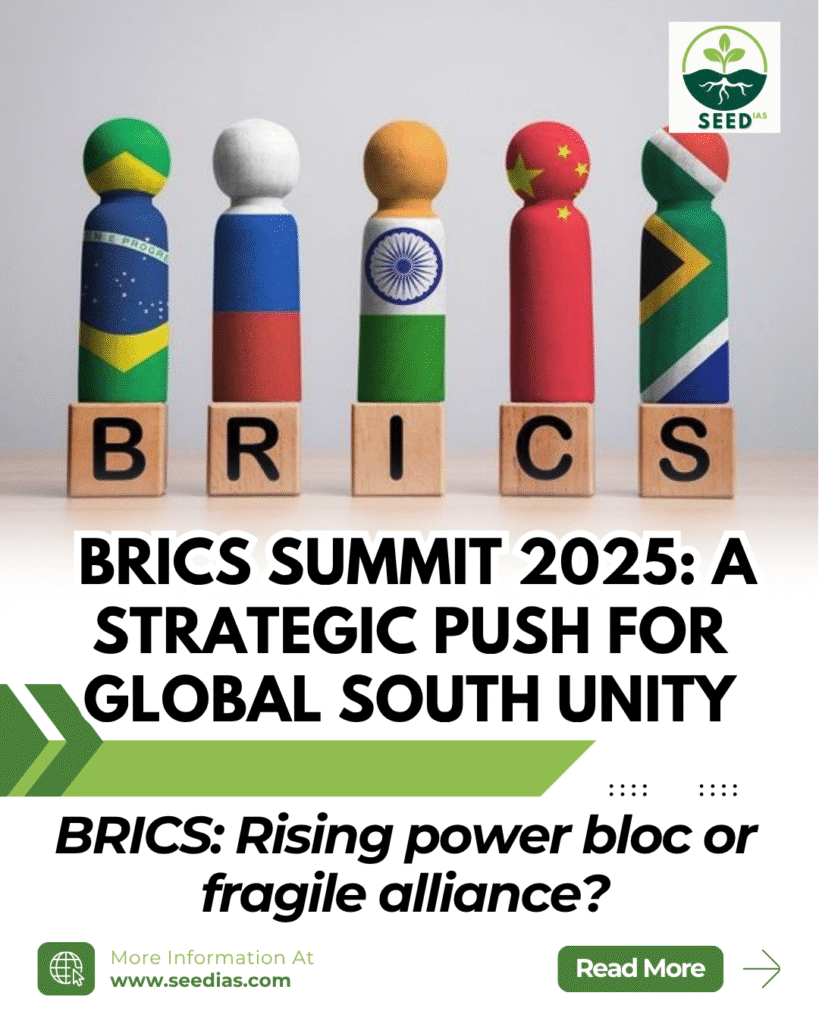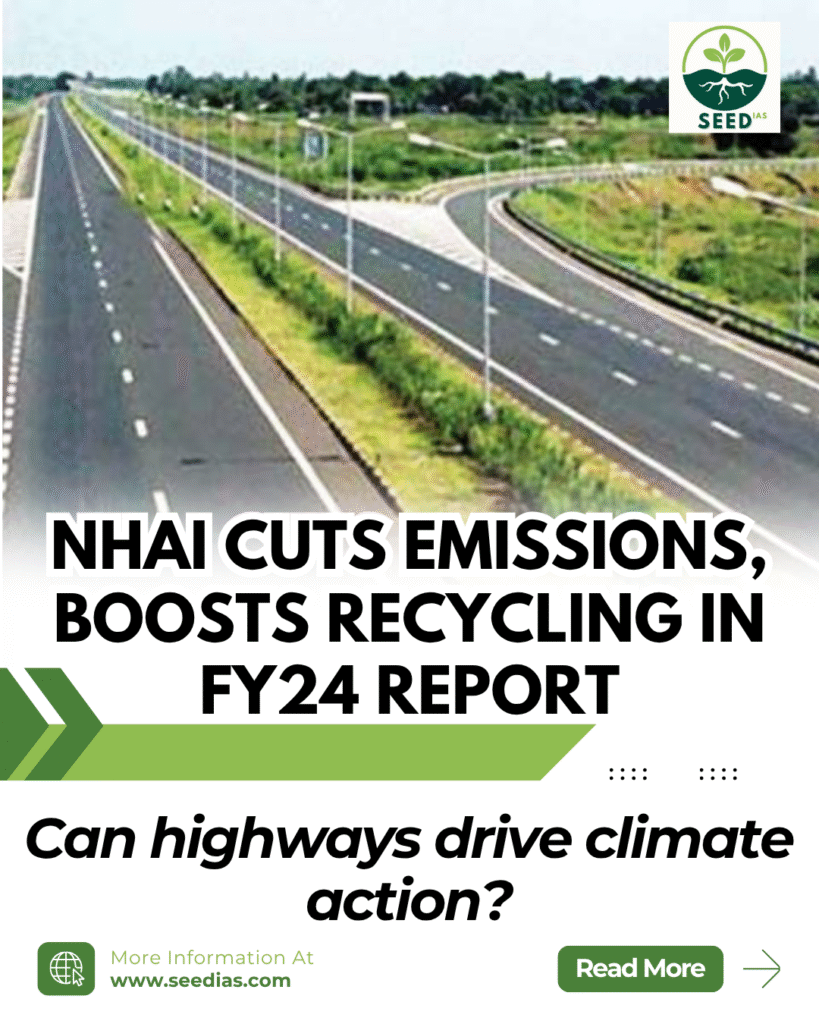Why in NEWS?
India’s PM participated in the 17th BRICS Summit held in Rio de Janeiro, Brazil, under the theme “Strengthening Global South Cooperation for More Inclusive and Sustainable Governance.”
- India will host the 18th BRICS Summit in 2026 as the next Chair.
- Indonesia officially joined BRICS, while 11 countries, including Nigeria, Cuba, Kazakhstan, and Vietnam, were welcomed as BRICS partner nations.
- The Rio de Janeiro Declaration was adopted at the summit.
Key Terms and Concepts
| Term | Explanation |
|---|---|
| BRICS | A group of major emerging economies: Brazil, Russia, India, China, and South Africa, formed in 2009. Now expanded to include countries like Iran, UAE, Egypt, Ethiopia, and Indonesia. |
| Rio de Janeiro Declaration | The official document adopted by BRICS 2025, outlining commitments on governance reform, sustainable development, peace, digital economy, and financial cooperation. |
| New Development Bank (NDB) | A multilateral bank established by BRICS in 2014 to fund infrastructure and sustainable development projects in member countries. |
| Dedollarisation | Reducing reliance on the US dollar in international trade and finance, a goal BRICS is pursuing through new payment mechanisms. |
Simple Explanation of the News
The 17th BRICS Summit in Brazil saw major developments:
- India will chair the next summit in 2026.
- BRICS expanded its influence by welcoming new full and partner members.
- The group emphasized the need for UNSC reform, stronger climate finance, a ceasefire in Gaza, and greater cooperation in tech and health.
- India condemned terrorism globally, including the Pahalgam attack, and reiterated its stance for principled rejection of terrorism.
- The bloc advanced new initiatives in cross-border payments, carbon trading, AI governance, and launched a health partnership on TB.
What is BRICS?
| Aspect | Details |
|---|---|
| Origin | Coined as ‘BRIC’ by Jim O’Neill in 2001 to denote Brazil, Russia, India, and China. |
| Formalisation | Began operating as a group during the G8 Outreach Summit in 2006; held its first summit in 2009 (Russia). |
| BRICS Formation | Became BRICS with the inclusion of South Africa in 2010. |
| New Members (2024–2025) | Iran, UAE, Egypt, Ethiopia (2024); Indonesia (2025). |
| Pending/Withdrawn Members | Saudi Arabia has not formalised membership; Argentina opted out. |
| Significance | Represents 45% of world’s population and 37.3% of global GDP—higher than EU (14.5%) and G7 (29.3%). |
| Key Initiatives | – New Development Bank (2014) – Contingent Reserve Arrangement (CRA) – BRICS Grain Exchange – BRICS Rapid Information Security Channel – STI Framework Programme (2015) |
How is BRICS Redefining Power Dynamics in Global Governance?
| Dimension | Details |
|---|---|
| Energy Security | BRICS members (with Iran, UAE, Saudi Arabia) now produce ~44% of global crude oil, influencing global prices and supply chains. |
| Strategic Dialogue | Offers a non-Western, neutral platform for members (e.g., India-China during Doklam) to resolve bilateral tensions. |
| Multilateral Reform | Acts as a collective voice pushing for reforms in UNSC, WTO, IMF, and World Bank to reflect emerging global realities. |
| Inclusivity & Outreach | Addition of diverse Global South members (many WTO members) enhances its international legitimacy and representation. |
| Emerging Bloc | Acts as a counterbalance to G7 and an influential voice in G20 on underrepresentation, development, and inequality. |
Key Challenges Hindering BRICS Functioning
| Challenge | Explanation |
|---|---|
| No Permanent Seat/Secretariat | Absence of institutional headquarters weakens coordination, slows decision-making. |
| Geopolitical Contradictions | Internal differences: Iran vs UAE, Egypt’s ties with the US, affect unity and functional consensus. |
| Weakening Economies | China’s slowdown (5.2% in 2023 → 4.6% in 2024 → 3.4% by 2028) and Russia’s war-related decline reduce economic influence. |
| Low Intra-BRICS Trade | Despite 18% of global trade, intra-BRICS trade is just 2.2% (2022), reflecting weak internal economic links. |
| Institutional Inertia | CrRA (BRICS Credit Rating Agency) did not materialize due to lack of consensus. |
| Limited Global Influence | BRICS+ holds only 19% IBRD voting power vs 40% by G7; NDB underfunded compared to IMF, World Bank, AIIB. |
| Slow Dedollarisation | Mixed progress—while China, Iran, and Russia trade in local currencies, no common currency exists yet. |
How Can BRICS Enhance Its Institutional Capacity and Leadership?
| Area of Reform | Proposed Measures |
|---|---|
| Institutional Reforms | – Establish permanent BRICS secretariat – Weighted voting for economic issues – Consensus retained for political issues – Clear membership criteria (GDP, economic stability) |
| Financial Integration | – Launch alternative SWIFT systems – Establish BRICS+ Development Bank 2.0 – Create a BRICS+ Free Trade Agreement (FTA) |
| Geopolitical Cooperation | – Unified stance on UNSC & WTO reforms – Stronger counter-terrorism cooperation – Promote peaceful resolution of conflicts through dialogue |
| Innovation Partnerships | – Launch BRICS+ Digital Alliance – Joint R&D in AI, green tech, semiconductors – Cooperation in space and nuclear sectors |
| Soft Power & Culture | – Establish BRICS+ University Network – Visa-free tourism blocs – Promote cultural exchange and student mobility |
In a Nutshell
Memory Code: BRICS-GRID
B – BRICS Expansion (Indonesia joins, partners added)
R – Reform push (UNSC, IMF, WTO)
I – India to host BRICS 2026
C – Climate finance & Carbon market MoU
S – Space Council, Security, Sovereignty
G – Gaza ceasefire & Global South focus
R – Rapid payment systems (Dedollarisation)
I – Inclusive growth goals
D – Digital, Data, Disease elimination partnerships
Prelims Practice Questions
- Which of the following countries officially joined BRICS during the 17th Summit?
A. Indonesia
B. Nigeria
C. Argentina
D. Saudi Arabia - Which BRICS initiative focuses on reducing dependence on the US Dollar?
A. CRA
B. Cross-Border Payments Initiative
C. BRICS+ University Network
D. Rio Declaration - Consider the following statements:
- The BRICS Space Council was formed at the 17th Summit.
- The BRICS Grain Exchange was launched in 2024.
- BRICS holds more than 50% of the voting power in the IBRD.
Which are correct?
A. 1 only
B. 1 and 2 only
C. 2 and 3 only
D. All three
Mains Practice Questions
- GS2 (International Relations):
Critically analyze how BRICS is reshaping global governance structures and power balances. (10 marks) - GS2 (IR – Global Groupings):
Discuss the challenges facing BRICS in achieving its goal of becoming the voice of the Global South. Suggest reforms to strengthen its institutional capacity. (15 marks)
(PYQ reference: 2020 GS2 – Role of G20, NAM in a changing global order)
Answer Key with Explanations
| Q No. | Answer | Explanation |
|---|---|---|
| 1 | A | Only Indonesia officially joined; others were welcomed as BRICS partners. |
| 2 | B | The Cross-Border Payments Initiative aims to reduce reliance on USD. |
| 3 | A | Only the formation of the BRICS Space Council was true; other statements are incorrect or outdated. |
















